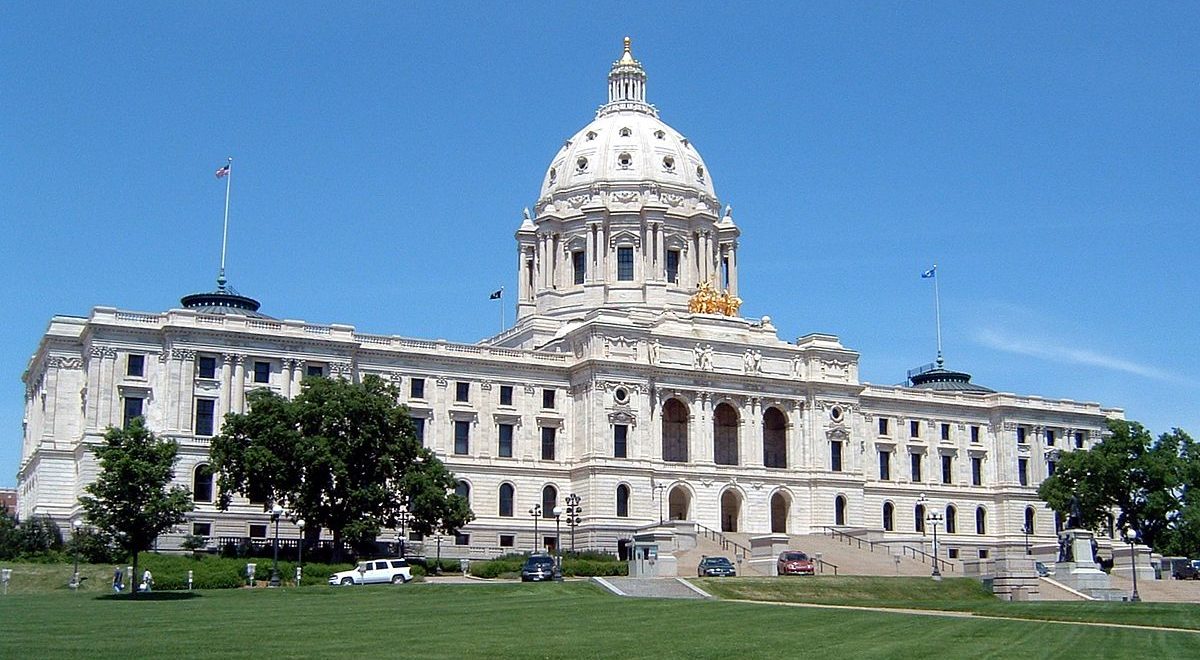100% clean energy mandates have been sweeping the nation. With Washington Governor Jay Inslee (D) signing a bill to move his state to 100% zero-carbon electricity, there are now six state-level jurisdictions (including Puerto Rico and Washington D.C.) that have set a schedule to phase out fossil fuels entirely by 2050 or sooner.
However, so far all of these are on the coasts (or in the case of Hawaii and Puerto Rico, islands), which for decades have led progressive policy changes. For the more conservative and de-industrialized Midwest, there aren’t even any particularly strong renewable energy mandates, except if you count one state: Minnesota.
Minnesota not only has the most aggressive renewable energy mandate in the region, but has been a bright spot for solar markets in the Midwest through its nationally leading community solar program. Late last night the Minnesota House acted to build on that progress by passing an omnibus energy (and a lot of other things) bill that includes a mandate that utilities source all of their power from carbon-free energy sources by 2050.
The Minnesota Solar Energy Industries Association (MnSEIA) said the bill could increase solar jobs in the state 10x. “We estimate that if this bill were to pass through the senate, then our state’s solar industry would balloon from 4,600 jobs to well over 45,000,” MnSEIA Executive Director David Shaffer told pv magazine.
But it may be too good to be true. Every state house to date that has passed a 100% clean energy mandate has been dominated by the Democratic Party. And while the Democratic Farmer-Labor Party holds a 75-59 majority in Minnesota’s House, in the Senate it’s a different story: a story where Republicans hold a 35-32 majority.
Sources close to this bill have made it clear to pv magazine that some features of this bill – specifically the 100% clean energy mandate – have a snowball’s chance in Hell in the Senate due to Republican opposition, and this concern was alluded to in Shaffer’s statements.
“It is clear that the Minnesota House is putting the pedal to the metal on clean energy, and its members are advancing strong policy provisions to build upon Minnesota’s strong history of driving the midwest on renewable energy,” stated Shaffer. “We hope the Senate comes along for the ride.”
Many mechanisms
The 100% clean energy mandate is not all that is in HB2208. The bill has a variety of other programs, including making carbon-free electricity the “favored method” to meet electric demand, and strengthening the language barring utilities from building new conventional generation unless they can prove that a renewable alternative is not in the public interest.
Here is the exact language from the bill:
In order to achieve the greenhouse gas reduction goals under section 216H.02, and the carbon-free standard under section 216B.1691, the commission shall not approve a new or refurbished nonrenewable energy facility in an integrated resource plan or a certificate of need, pursuant to under section 216B.243, or in any proceeding in which a utility seeks to construct an electric generating facility or procure electricity or capacity, nor shall the commission approve a power purchase agreement for power with a nonrenewable energy facility, or allow rate recovery pursuant to under section 216B.16 for such a nonrenewable energy facility, unless the utility has demonstrated by clear and convincing evidence that a renewable energy facility, alone or in combination with other clean energy resources, is not in the public interest.
It would also mandate the creation of incentives for rooftop PV systems 40kW and smaller, provide funding for energy storage studies, and create a “solar for schools” program.
Finally, it makes tweaks to the state’s community solar program, including expanding the cap on the size of eligible installations from 1 MW to 3 MW and putting the state’s Department of Commerce in charge of implementing the program, including calculating the rate paid to subscribers and submitting the rate to the commission for approval.
Vote Solar says that the community solar provisions are particularly important. “It’s especially exciting to see Minnesota taking steps to make sure that 100 percent clean energy vision is fair and inclusive by expanding community solar opportunity,” stated Becky Stanfield, Midwest States Senior Director for Vote Solar.
So while the 100% clean energy mandate is unlikely to pass, there is the possibility that at least some of these other measures make it through, which could be important for the ongoing growth of the state’s solar and energy storage markets, and that of the entire Midwest.
This content is protected by copyright and may not be reused. If you want to cooperate with us and would like to reuse some of our content, please contact: editors@pv-magazine.com.









By submitting this form you agree to pv magazine using your data for the purposes of publishing your comment.
Your personal data will only be disclosed or otherwise transmitted to third parties for the purposes of spam filtering or if this is necessary for technical maintenance of the website. Any other transfer to third parties will not take place unless this is justified on the basis of applicable data protection regulations or if pv magazine is legally obliged to do so.
You may revoke this consent at any time with effect for the future, in which case your personal data will be deleted immediately. Otherwise, your data will be deleted if pv magazine has processed your request or the purpose of data storage is fulfilled.
Further information on data privacy can be found in our Data Protection Policy.